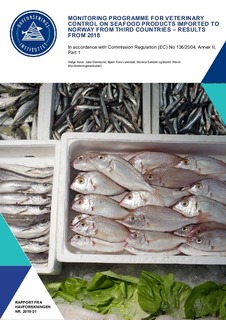| dc.description.abstract | This report summarises results from the ongoing monitoring programme for veterinary border control on seafood products imported to Norway from countries outside the EU and the European Economic Area from 2018. The Institute of Marine Research (IMR) carried out the analytical work on behalf of the Norwegian Food Safety Authority (NFSA), in cooperation with the personnel at the Norwegian Border Inspection Posts (BIP). We want to thank NFSA for very good cooperation during the conduct of this monitoring programme. An up to date risk assessment for different groups of imported products, made the basis for the sampling plans and the selection of analytical activities. The current trend of hazards, as reported in The Rapid Alert System for Food and Feed (RASFF) notification system, the compositional nature of the products and the annual import quantity of relevant products, was evaluated in this risk assessment. A total of 122 samples from the NFSA, collected at the BIPs, were examined by a selection of analytical methods and assays for microorganisms, parasites and undesirable chemical substances. The analytical data are listed in Annex 1 and are summarised below. Microbiological analyses were performed on 104 samples. The results for microbiological indicator organisms for faecal contamination were mostly below detection limit or showed low bacterial counts. The microbiological quality parameters and indicator organisms for faecal contamination generally showed low numbers. However, higher counts were found in one sample of Yellowfin tuna imported from the Maldives and one sample of Pacific cod imported from Thailand. L. monocytogenes was detected in low quantity in one sample of Pacific cod from Thailand and in one sample of Norwegian herring re-imported to Norway from Egypt. No samples had pathogens in the genera Salmonella. Enterobacteriaceae was detected in one sample of feed imported from Chile.Yeast was found in two samples of feed from Chile, and in one sample of dried Yellow Stripe Trevally from Thailand and in Migas from China. Mould was detected in the same dried Yellow Stripe Trevally from Thailand and in Migas from China. Parasitological examination was carried out on 40 fish samples. Nematodes were found in nine of them (22.5%). Since fish were imported frozen, nematodes were dead and not infective. Thirteen seafood samples originating from aquaculture were analysed for residues of prohibited veterinary medicines, unauthorised dyes and antibacterial agents. None of these were detected. The chemical spoilage indicators histamine and total volatile basic nitrogen was examined in nineteen samples and all results were compliant with the maximum levels. Undesirable trace elements were measured in 89 samples. A sample of canned sardine in oil from the Philippines exceeded the maximum Cd level. A sample of small crabs from Thailand, assuming they were intended to be consumed whole, were slightly above the Pb maximum level. A frozen fillet sample of yellowfin tuna imported from Vietnam exceeded the Hg maximum level. Twenty-eight samples were analysed for the persistent organic pollutants dioxins/ furans and PCBs (DLPCBs and NDLPCBs), the PBDE class of compounds, the PAH class of compounds and organochlorine pesticides. One sample of fish oil from Turkey was found non-compliant with its maximum levels for dioxins and for the sum of dioxins and dioxin like PCBs. The levels of PBDEs in twenty-eight samples, and also the fifteen samples analysed for organochlorine pesticides, were within a range commonly observed in seafood. For the PAH class of compounds, one sample was analysed, and found compliant with its maximum levels. | nb_NO |
